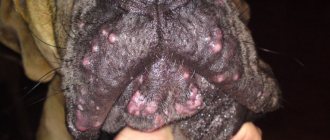Mechanism of development of allergic otitis
Otitis media occurs in dogs most often due to allergic reactions in the ear. External agents, allergens, enter the body and quickly spread; the body secretes lymphocytes to fight them.
Symptoms of otitis media appear when the body uses histamines to help, which in turn improves vascular permeability. As a result of these processes, plaques and nodes appear in the area of the outer ear. Inflammation with otitis media in dogs most often occurs on both ears at the same time.
Typically, allergic agents cause itching in the ear area of dogs. The pet scratches the area of irritation until there are open wounds, other pathogens get there and other infections are added to otitis media of allergic etiology.
Causes of the disease
Any allergy is a reaction of the immune system to substances from the environment. In a healthy individual they leave the body. As the disease progresses, the irritant accumulates and causes various symptoms. Allergic reactions in dogs have a number of features:
- pronounced nature of manifestation;
- a large number of substances are allergens;
- Symptoms intensify with age;
- The skin is the first to suffer.
Veterinarians do not have a consensus on the occurrence of the disease. It is believed that everything is decided by a combination of factors. Some breeds (pugs and others) have a hereditary predisposition to developing food allergies. Worm infestations seriously compromise a dog's immune system.
Provoking factors include structural features of organs and the functioning of the endocrine and nervous systems. Long-term stress leads to a decrease in immunity. This is a consequence of chronic infectious diseases.
Causes of the disease
You need to understand that diseases of allergenic etiology can appear in any animal, dogs are no exception. Any bacteria, even the most harmless to other pets, can become external allergens. The immune system releases cells to fight them, which can cause unexpected reactions.
Experts identify several causes and risk groups for the appearance of allergic otitis media:
- Heredity. If the dog's mother or father has had problems with otitis media, the likelihood of its occurrence increases.
- Suppressed immune system. An unbalanced diet and rare walks reduce the animal’s immunity to various pathogens.
- Introduction of a new product for the pet in large quantities.
- The use of new animal care products that have not been used before.
- Medications. May cause side effects such as allergies. Although cases of otitis media for this reason are extremely rare, they do exist.
As in people, the catalyst for allergies can be oversaturation of the dog’s body with large amounts of the same food. Each pet has its own list of potentially dangerous products. Veterinarians say fish, seafood, smoked meats, sweets, fruits and dried fruits are highly allergenic for dogs.
Allergy symptoms in dogs
The most common indicator is itching; the dog constantly itches, starts rubbing against furniture, and often scratches its ears.
Almost every animal has fur; for this reason, it is not always possible to notice the first manifestations of an allergic reaction immediately. Some dog owners, during contact with their pet, examine its skin, in particular its ears and face. In short-haired breeds, it is much easier to detect the first symptoms of an allergic reaction.
The conditions described below are the result of allergies in a dog.
- The most common indicator is itching; the dog constantly itches, begins to rub against furniture, and often scratches its ears.
- Discharge from the nasal and lacrimal glands.
- The skin around the paws takes on a red tint.
- Swelling and scratching appear on any part of the pet's body.
- The pet develops a white coating and the skin becomes very dry.
- The process of hair loss begins, bald spots appear, and there are no symptoms of inflammation.
- Problems with the gastrointestinal tract, in particular diarrhea.
- Sweating occurs in the armpit area.
Competent dog owners know that sweat glands in dogs are located only in the paw area. If there are signs of sweating in the armpit area, this is an indicator of disturbances in the functioning of the body, most often, this is a sign of an allergic reaction that has begun.
Specific manifestations of types of allergies
An allergic reaction to fleas in dogs is necessarily accompanied by the presence of some parasites in the dog’s body
A food allergic reaction in dogs is characterized by severe itching, hair loss and the appearance of bald spots. Possible vomiting, accumulation of effusion in the armpits and chest area, active work of the lacrimal glands. The above symptoms most often occur with a chicken allergy. Almost all feed mixtures contain its meat. As a result, the body begins to become oversaturated with certain groups of proteins and, as a result, an allergic reaction begins.
An allergic reaction to fleas in dogs is necessarily accompanied by the presence of some parasites in the dog’s body. Also, “flea” dermatitis differs from others in the appearance of a rash in the groin area, the skin begins to peel off and become covered with white crusts.
If an allergy occurs as a result of contact with objects of chemical origin, then common symptoms are urticaria in the immediate areas of contact of the allergen with the dog’s skin, interdigital eczema, and irritation in the paw area.
In the event of an allergic reaction of the body to medications, the manifestations of the allergy will be the smooth edges of hives, which appear only in the area of the muzzle. Depending on the frequency of taking the drug, the allergic reaction may go away and return again. Quite often, when drugs are the allergen, anaphylactic shock occurs.
If we talk about the infectious nature of allergies, such a reactive reaction is accompanied by a pathology of a fungal or bacterial nature.
Allergic otitis in a pet is characterized by the formation of swelling in the auditory canal, the ears have an increased temperature. The dog constantly scratches its ears, walks tired and lethargic.
Allergies of an autoimmune nature include lupus erythematosus and bullous pemphigoid. Cutaneous vasculitis should not be ruled out.
Characteristic symptoms
Allergic otitis in dogs has its own characteristic symptoms that will help you quickly recognize the disease. The first sign will be a decrease in appetite and inactivity of the pet. Veterinarians identify a number of obvious symptoms of ear inflammation due to allergies:
- Pain in the outer ear area. The pain increases when touched, the dog begins to bark and run away.
- Visual enlargement of the ear in size, severe redness, and hair may fall out.
- Discharge from the ear is gray, yellow, brown. They can also be transparent.
- Unpleasant odor from the ear.
- Atypical behavior. Usually dogs begin to scratch their ears and bark in pain. They begin to characteristically shake their ears.
Read Best Flea Treatments for 1, 2 or 3 Months Old Puppies
The situation can become dangerous if bloody discharge appears from the ears. In the acute form of the disease, the body temperature may rise significantly. In severe condition, the disease can cause enlarged lymph nodes. In this case, the dog may partially or completely lose hearing, and sudden manifestations of aggression are typical.
The allergen can irritate not only the ears, but also other organs. Therefore, symptoms that are not characteristic of otitis media, but characteristic of allergies, may also occur. Watery eyes, runny nose, cough, diarrhea and constipation.
How to distinguish from other forms of otitis
In addition to allergic, there is also purulent and fungal otitis, but they are not so common. To distinguish these types from each other, several characteristic symptoms can be identified:
- Purulent otitis media manifests itself in a small seal in the ear and a sharp sour odor.
- Fungal otitis is characterized by increased secretion of sulfur and the formation of a large number of crusts in the auricle.
Causes
There are many reasons why a dog's ears may turn red. Some of them are not dangerous at all and only reflect her emotional state at a particular moment, while others, without the intervention of a specialist, can lead to serious complications or even the death of the pet. Therefore, only after noticing a change in the color of the skin, it is necessary to take care of the health of the animal and find out the root cause of what is happening.
The most common reasons:
- Allergy . It can manifest as itching, redness, the formation of small pimples or scabs followed by swelling. The reason could be almost anything. Most often these are components of food or medicine, but with the same degree of probability the smell of the owner’s new perfume or the fabric of a new suit can spoil the animal’s well-being. If allergy symptoms appear, it is necessary to exclude all new elements and select a suitable canine antihistamine.
- Infections and parasites . This can be either the root cause or a secondary infection due to a decrease in immunity due to allergies. Accompanied by itching, pain, active secretion of sulfur or pus. In this case, the ear not only turns red, but also becomes inflamed, thickening, and minor diseases and ulcers often appear, accompanied by an unpleasant odor.
- A foreign body is the most easily solved problem. Dogs that regularly come into contact with nature suffer from this especially. A plant seed or blade of grass can cause many problems if it is not removed in time. It is not difficult to identify the problem. In this case, only one ear turns red and not completely; often the foreign body is visible to the naked eye. In most cases, owners deal with the problem on their own using tweezers.
- Trauma . Representatives of breeds with large ears themselves injure their ears during active games or when scratching. In this case, you only need to treat open wounds and make sure that infection does not develop. It is usually easy to determine that the color has changed due to injury. In addition to visible scratches, there is an increase in temperature and slight swelling.
Diagnostics
For effective treatment of otitis media, it is necessary to make a correct diagnosis. Veterinary clinics have all the necessary conditions for this. Initially, the veterinarian will interview the pet owner, then perform an examination and take an anamnesis. Based on the collected data, the specialist decides what diagnostic measures need to be taken. Most often, the following methods are used to confirm allergic otitis:
- Allergy test. To do this, they take a swab from the auricle in the inflamed area and conduct a study of the microflora and the presence of parasites.
- Urine and blood tests.
- Study of the hormonal state and levels of hormones of the adrenal and thyroid glands.
- Biopsy.
- X-ray, ultrasound, MRI or CT scan at the veterinarian’s choice.
Only after confirming the diagnosis using one or more of the above methods can the veterinarian decide on treatment. It is important to understand that the disease does not go away on its own and requires treatment without fail.
Homemade pet diet
The principles of feeding a dog at home are as follows:
- The animal's weekly diet must include meat and meat products. Meat must be given to your pet raw, without any thermal or chemical treatment or mechanical grinding.
- Fish is given to your dog if you are sure that the product is not an allergen.
- Do not mince meat, even if the dog has no teeth. The pet is able to swallow food in pieces that it can digest.
- Plant foods with coarse fiber are grated on a coarse grater and finely chopped with a knife or food processor.
- The dog does not need liquid food; soups are not needed.
- A combination of fish and meat products is allowed, provided there is no allergy to any component of the diet.
If you feed your dog fermented milk products, do not mix them in the general feeding with plant components of the pet’s menu, meat and fish dishes.
The main condition for any type of feeding is the dog’s constant access to drinking water in sufficient quantities.
Treatment at home
Therapy for allergic ear inflammation is aimed at eliminating pain, redness, strengthening the immune system and detoxifying the body. Complex treatment can be carried out at home. In this case, a specialist must choose treatment methods, the sequence of methods, and the dosage of drugs. In any case, you need to follow quickly, because such an illness is very stressful for the animal.
Read: How to give injections to a dog and where to give it
First aid for a pet
In case of a sharp exacerbation of the disease and it is impossible to immediately attract the help of a veterinarian, you need to provide the dog with first aid. To quickly alleviate your pet's condition, you need to give him any antihistamine. The dosage is calculated depending on body weight. If your animal's ear is very itchy, you can anoint the affected area with Triderm or Lanolin cream. Emergency care will give you time to calmly take your animal to the veterinarian.
Treatment with medications
The veterinarian prescribes medications; it is not recommended to choose the medications yourself. Histamine H1 receptor blockers and antiallergic drugs are usually prescribed. Based on medical history and diagnostic measures, the dog may be prescribed the following medications in the form of tablets or mixtures:
- Suprastin;
- Tavegil;
- Desloratadine;
- Diphenhydramine.
If the animal's weight exceeds 10 kg. An anesthetic drug No-Shpa, Drotaverine, or Spasmonet may be prescribed. Such preparations are practical and easy to use at home. Drops for dogs have their own characteristics, you need to know how to use them.
The complex of therapeutic measures can be supplemented with the use of vitamin complexes. Not all veterinarians talk about them, so as not to increase the cost of treatment.
Using ear drops
Ear drops are most effective for allergic otitis media. This form of medicine has a number of advantages: high efficiency, practicality, and the fastest possible effect. Most often, experts prescribe the following drops for dog ears:
- Bars - quickly relieve allergic reactions;
- Lotion Rosinka - consists of natural substances, soothes inflammation, eliminates itching;
- Dekta - saves from scabies;
- Otodepine is used for hygienic care;
- Otodepine is a drug with a high antiallergic effect;
- Sofradex is an antibiotic with a high anti-inflammatory effect.
You need to treat your dog with drops very carefully. Before using the products, you need to clean the surface of the ear from secretions and remove the crusts. This must be done very carefully; with otitis media, the animal’s ear is very sensitive, it can easily be injured and complicate the situation.
Do not heat or put cold drops into the ear. The product should be at room temperature - 19-23 degrees.
Depending on the doctor’s recommendations, the drops should be dripped either directly onto the visible area of inflammation, or into the ear canal.
What to do if your pet has anaphylaxis?
In most cases, anaphylactic shock occurs due to exposure to drugs or insect bites.
The nature of anaphylactic shock can be different, but it always occurs the same way. Systemic and local manifestations of anaphylaxis are possible, while local manifestations may be complicated by systemic manifestations. In most cases, anaphylactic shock occurs due to exposure to drugs or insect bites.
Local manifestations of anaphylaxis include urticaria and angioedema. Systemic symptoms of anaphylactic shock are vomiting, fainting, and heart and vascular failure.
If your pet goes into anaphylactic shock, it is necessary to take him to a veterinary hospital as quickly as possible. If no action is taken, the animal will die within an hour.
What should the veterinarian do?
A healthcare professional should administer an antihistamine
- A healthcare professional should administer an antihistamine.
- A drug is injected that supports the functioning of the heart muscle.
- A steroid is injected. The veterinarian will need to calculate the dosage depending on the size of the pet.
- A dose of ascorbic acid and glucose is administered.
- Immunofan is administered intravenously.
After the measures described above, the pet needs to drink calcium chloride within 24 hours to relieve itching and redness, veterinarians prescribe special sprays.
What is prohibited to do
It is much easier to harm a pet when treating it at home than to cure it. Mistakes made by owners often provoke complications of the disease. Veterinarians emphasize the importance of a list of what not to do when treating allergic otitis media in dogs:
- Hygienic treatment of ears from secretions and wax crusts cannot be carried out using sharp objects.
- Before examining or instilling medications into the dog’s ear, the owner must wash his hands. It is prohibited to touch the sore ear with dirty fingers.
- The use of low-quality ear buds and cotton pads is prohibited. Such products leave pieces of cotton wool in the ear, which then decompose and rot there.
- You should not drop peroxide, brilliant green, or even iodine onto the ear of a sick pet. Their effectiveness is low, and the dog will suffer from pain. If the dog is large, this can be dangerous for the owner, in which case the dog loses control of itself.
Read Signs of worms in dogs: how to spot worms
It is not recommended to choose medications for therapy on your own. The choice of drug should be done by a specialist.
Should I switch to factory feed?
Food allergy is a nonspecific disease that is difficult to diagnose. An argument against factory-made food is the following fact: many cases of food allergies occur in dogs that eat ready-made dry food for a significant period of time.
Today, such finished products are promoted in the media and by veterinary experts.
As a result, most breeders and ordinary pet owners are convinced that ready-made factory products for dogs are completely harmless and contain the necessary set of nutrients and microelements for a full life for a pet.
It is extremely rare that the occurrence of food allergies is associated with prepared foods, and this is one of the common sources of allergenic products for pets. Before switching to commercial food, carefully read the composition so that it does not contain an allergen that negatively affects your pet.
Forecast and consequences
In general, the disease is easy to treat, the course duration is on average 1 week until complete recovery. The mortality rate is about 10% of the total number of cases. If untimely or incorrect treatment after an acute form of allergic otitis media occurs, the following consequences may occur:
- Partial or complete hearing loss;
- Autophony is an increased perception of an animal’s own voice and breathing;
The likelihood of such consequences is low for those animals that have undergone proper treatment.
What ear drops for dogs are used for otitis and other diseases
Various ear diseases are quite common among pets. In addition to ear mites and allergies, these can be otitis media. Dogs with long drooping ears are especially susceptible to them. Only a doctor can make an accurate diagnosis for a pet, but it is possible to alleviate the animal’s suffering. There are various drops for dogs (ears), which are used to hygienize the ear canal or treat inflammation. But if after a few days the pet does not feel better, you need to go to the veterinarian, because advanced diseases can lead to serious problems.
What ear drops are there for dogs?
Preparations for hygienic treatment must be used regularly. This will help not only clean the animal’s ear, but also prevent the development of inflammatory diseases. Basically, these drugs are made on the basis of herbal ingredients and are absolutely safe for pets.
- Hygienic drops and lotions are widely available in pet stores, so you can choose any drug: Bars, Otifri, Otodepin, Rosinka and others.
- Antibiotic ear drops for dogs should be used carefully and only after a doctor's prescription. After all, some bacteria may be resistant to such drugs, and fungi and parasites multiply even faster due to their use. Therefore, when using ear drops on your own, you need to read their composition. The following drugs contain antibiotics: “Otibiovin”, “Surolan”, “Anandin”, “Otovedin” and others.
- The most effective are drops that not only have antimicrobial, anti-inflammatory and antipruritic effects, but also destroy fungi and parasites. Such complex drugs will help alleviate the suffering of the animal before diagnosis is made. You can use drops of “Otoferonol”, “Dekta”, “Aurikan”, “Bars”, “Anandin Plus” and others.
- Drops for allergic diseases relieve itching and irritation. But at the same time, it is recommended to exclude the animal from contact with the allergen and give antihistamines internally. To relieve itching, you can use drops of “Bars”, “Sofradex”, “Otodepin” and others.
Ear drops for dogs against otitis
If your pet shakes its ears, constantly scratches them, experiences pain, swelling, redness, accumulation of wax is visible inside the auricle, and an unpleasant odor is felt, you need to show the animal to a veterinarian. Inflammatory ear diseases can have different causes, and treatment depends on this.
If you suspect otitis media, you should not immediately use ear drops for dogs containing an antibiotic. Only after tests and diagnosis can a doctor prescribe such drugs. The choice of medication depends on the form of the disease.
- For fungal otitis, it is necessary to use complex drugs based on miconazole, clotrimazole or nystatin. They will not only relieve itching and inflammation, but also destroy the fungus. You can use the following ear drops for dogs: “Surolan” (has antiparasitic, anti-inflammatory and antimicrobial effects), “Aurizon” (destroys both fungi and bacteria), “Otonazole” (effective against fungal infections, relieves inflammation and itching).
- To treat allergic otitis media, you need to instill drugs containing antihistamines or glucocorticoids: Sofradex, Anauran and others. They will help relieve itching and swelling.
- Traumatic otitis is treated with wound-healing drugs. After treating the auricle, you can instill the following drops: “Otopedin”, “Aurikan” and others.
- Purulent bacterial otitis media is the most difficult to treat. After identifying the causative agent of the disease, antibiotic drops are prescribed. Treatment should be comprehensive: the drug is instilled only after hygienic treatment of the dog’s ears. The following drops are used: “Normax”, “Candibiotic”, “Otipax”, “Otibiovet”, “Anandin” and others.
- Otitis media can also be caused by ear mites. In this case, complex treatment and the use of drops that have an insectoacaricidal effect are also necessary.
Drops against ear mites
Such an infection is easy to identify yourself. With ear mites, dark plaque accumulates in the dog's ear. If the injury is severe, fluid may appear and the plaque may spread to the animal’s temples. The pet constantly shakes its ears and scratches them. Treatment against ticks should be carried out several times a day. Treatment is often lengthy, but three weeks is usually sufficient. If infection recurs or complications occur, it is better to show your pet to a veterinarian. The following drugs are used for the treatment of otodecosis: “Bars”, “Decta”, “Anandin Plus”, “Tsipam”, “Insectal Plus”, “Amicrazin” and others.
Drops for hygienic treatment of ears
Your pet's ear canal needs to be cleaned regularly. It is advisable to do this once a week, and for animals with floppy ears - daily. This will help prevent the development of inflammation and begin treatment of the parasitic infection at an early stage of its appearance. There are various hygienic ear drops for dogs and cats:
- "Rosinka" is a herbal preparation containing propolis, extracts of St. John's wort, sage and calendula. It not only cleanses the ear, but also relieves swelling and heals small wounds.
- "Otopedin" is made on the basis of pine oil and mullein extract and has an anti-inflammatory and wound-healing effect.
- “Fitolar Lotion-Spray” is a herbal preparation that not only cleanses the ear, but is used in the complex treatment of infections.
- Epi-Otik lotion is used for hygienic treatment of ears for otitis.
Rules for using ear drops
Before using any drug, you should carefully read the instructions. It is advisable to take your pet to the veterinarian so that the doctor can help in choosing a medicine.
To increase the effectiveness of treatment, you need to follow some rules:
- before instilling the drug, it is necessary to clean the pet’s ear of crusts and wax;
- when processing, do not insert the cotton swab deeply so as not to damage the eardrum;
- the drops need to be warmed in your hand or in warm water;
- when instilled, the pet’s ear is pulled back, and then you need to press it a little and massage it so that the drug is distributed over the entire surface;
- During the procedure, it is important to praise the dog and then give it a treat.
fb.ru>
Prevention
The main rule for the prevention of allergy-related diseases is the elimination of the allergen. After completing the course of treatment, it is necessary to exclude all potential allergenic foods, care products, etc. You can reduce the risk of disease using other measures:
- There is no need to wash your dog's ears every time after a walk. This harms the microflora of the ear, it is susceptible to external irritants.
- Protect the animal from getting moisture in its ears.
- Stop walking in windy and frosty weather.
It is also undesirable to expose your pet to the risk of ear injury. Preventive visits to the veterinarian are recommended, during which the doctor will check not only the pet’s ears, but also the general condition.
How to treat food allergies
There are two first stages of treatment:
- Put your dog on a homemade diet.
- Introduce hydrolyzed proteins into your dog's diet.
Regardless of the chosen treatment regimen, a visible effect will occur in at least a couple of months.
One of the simple and affordable ways to treat food allergies in an animal is to switch to a homemade diet. This is a budget option that allows you to clearly control the intake of all nutrients into your dog’s body, including proteins.
The likely difficulty is that the animal has indigestion. However, soon the unwanted symptoms disappear without a trace.
Switching to factory-made food to get rid of allergies is justified if you know the product that causes allergies in your four-legged friend, and if you are sure that the specific food does not contain it.
An effective way to combat allergies is to feed hydrolyzed proteins. But this is an expensive method that is not available to everyone. The dog owner is forced to purchase special food containing chemically processed protein, in which the molecular size is significantly reduced by hydrolysis.
Veterinarians! How is otitis media treated in dogs?
Answers:
Boris Agarkov
Shar Peis are more prone to ear infections due to their narrow ear canal. For treatment, you need to clean your ears once a day, preferably with a special liquid, such as Epiotik. And apply good broad-spectrum drops twice a day. Surolan, Kanaural or Aurizon are best.
Nadezhda ***
otibiovin
Masha Romanova
Dilute 1 tablet of furacillin into half a glass of vodka. Clean your ears with this solution 2 times a week. during an exacerbation, 3 times a day for up to 10 days in a row. from drops. the best ones are OTONAZOL.. blockades are needed. Only veterinarians make them. 5-7 blockades every 3 days.
Matvey Karetnik
There are good ear drops called “Bars”. Helps with inflammation.
Veniamin and Elena Fedorov
What if it’s not otitis media but a fungus? and you will treat for otitis media and will only make it worse
Larisa Churkina
Did you make the diagnosis yourself? Maybe it’s worth showing the animal to a specialist?
Margarita Filina
Surolan drops in a pet pharmacy. Before this, wipe with chlorhexyline on a cotton swab. Any type of otitis is treated, regardless of the cause, including those caused by fungi. And Bars can hardly be called a treatment.
Elena Kudryavtseva
I’m not a veterinarian, but yesterday we went to him - we also have unilateral otitis media, we were prescribed Kanaural - they are not very cheap, but the best. Instructions are included; before use, clean your ears with peroxide.
Helgda
Do a cytological examination of smears from the skin and external auditory canal to exclude and identify causes (parasites, fungal flora, bacteria) and culture for sensitivity to antibiotics.
Levi
if otitis is caused by an allergic reaction, then after taking antihistamines it will also go away. But if this is an exacerbation of a chronic form, provoked by an allergy, then that’s a different story. In any case, you need to take a smear. I personally love Oridermil. But be sure to do it for 7 days and no less, even if improvement occurs immediately, otherwise you will become addicted.
How to treat allergic otitis (scrofula) in dogs?
Answers:
breeze
First of all, change the dog's diet!!!! antihistamines, calcium chloride orally, and lubricate the ear with Lorinden Triderm or others
Buldoga Buldogovna
1 remove the allergen 2 give the dog Exekan 3 drip the ears with SUROLAN
Diana
Natalya, are you sure of the diagnosis? if there is an inflammatory process, you need to go to the veterinarian, giving a blockade (such an injection) to the dog will be much easier and the treatment will go faster. I agree with Oksana, you need to change your diet. completely remove flour and sweets from the dog’s diet. Plus, you also need to buy a syringe with ointment at the veterinary hospital; I don’t remember what it’s called. in a word, don’t be too lazy to go to the branch. and the sooner the topic is treated better. good luck, health to the dog.
Natalis
Consult a veterinarian











